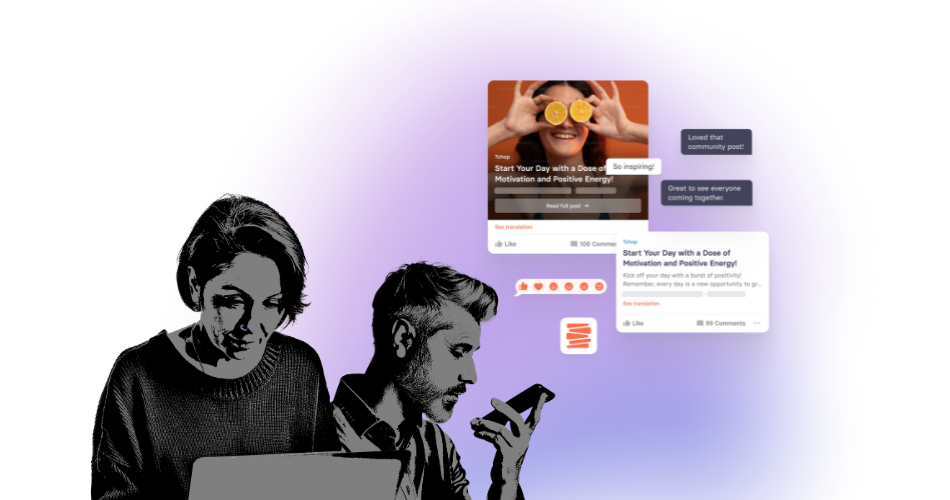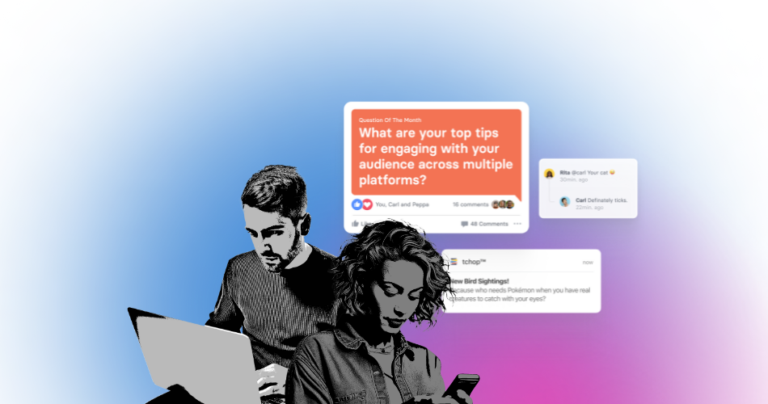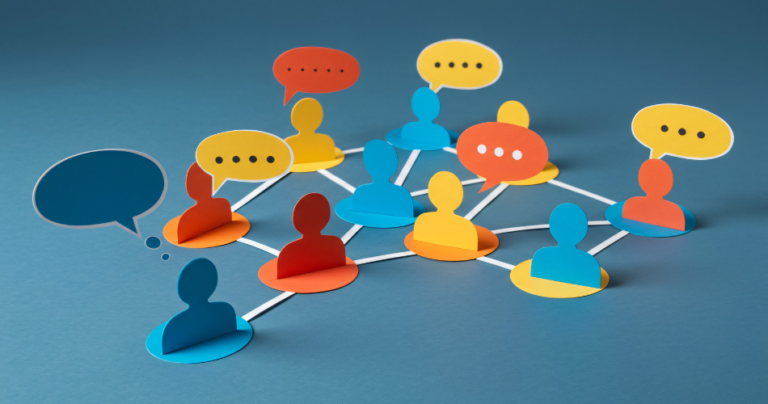Community-led growth is having a moment. Scroll through any marketing conference agenda or LinkedIn feed, and there it is again: the promise that if you just “activate your community,” growth will happen naturally. It sounds almost too good to be true. Build connection, and conversion takes care of itself.
Except it doesn’t work that way for most brands.
What actually happens is this. Teams launch a Discord server or a Slack channel. They create an ambassador program or a membership space. They post content, run events, and watch the initial metrics climb. For a few weeks, everything looks great. People join. Engagement spikes. Everyone feels optimistic.
Then the energy drains. Participation slows. Conversations die in the thread. Another community initiative joins the graveyard of things that sounded good in the planning doc but couldn’t sustain themselves in reality.
Here’s what’s really happening. Most brands are treating community like a campaign when it actually works more like physics. The ones that succeed don’t just gather people and hope for the best. They’re building something more fundamental: systems where participation naturally creates more participation.
They’re designing loops.
Not content calendars or engagement tactics, but actual behavioural loops where one person’s action sparks another’s, creating momentum that doesn’t need constant manual effort to survive. That’s the quiet difference between communities that grow and communities that exhaust their teams trying to keep them alive.
And that’s exactly what most brands, even the ones investing heavily in community, still haven’t figured out how to build.
What really compounds inside a community (hint: not content)
Most communities fail because they’re fuelled by the wrong kind of energy.
Look at what brands typically call “engagement.” Someone likes a post. Reacts to an update. Joins a webinar. Comments once. Each creates a blip on a dashboard, a spike on Tuesday and silence by Thursday. These are surface signals, visible and measurable, but they go nowhere.
Real growth happens when participation generates more participation. When one person’s action sparks another’s, and that reaction becomes the reason for the next action. That’s the moment a community stops acting like an audience and starts acting like an organism.
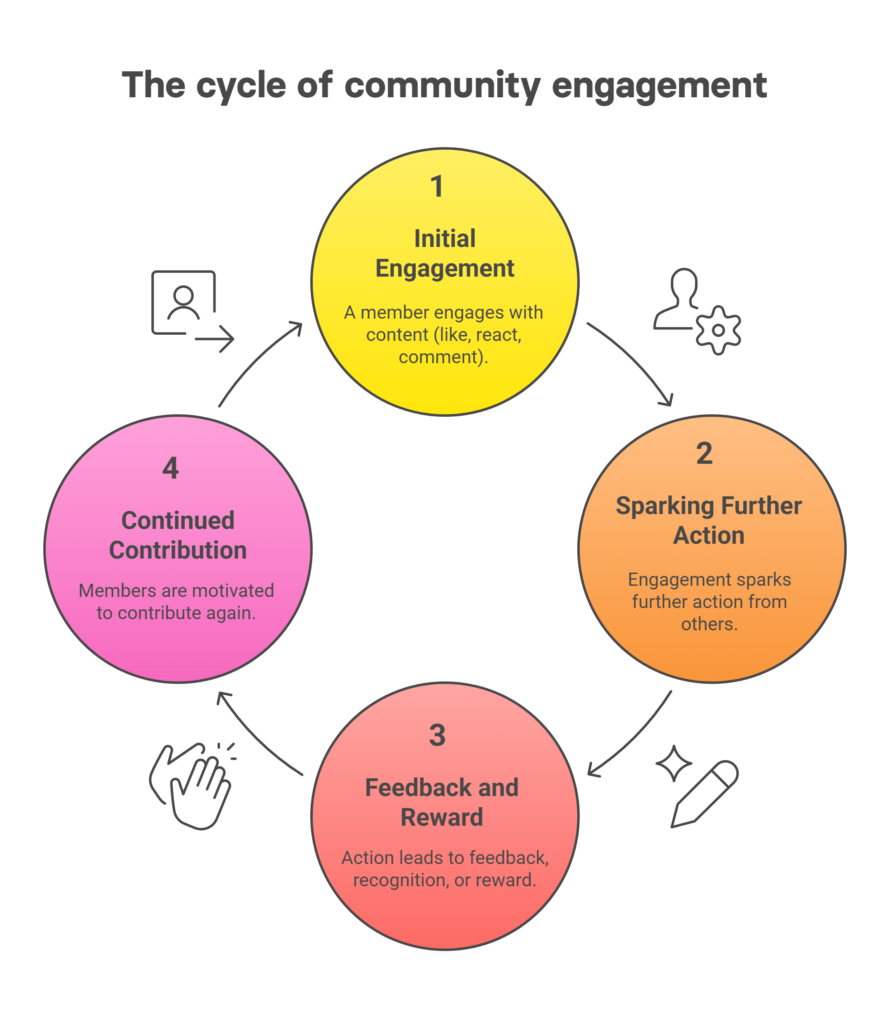
Duolingo understands this. Millions return daily not because of the streak counter alone, but because of what happens after you finish a lesson. Instant feedback. A streak earned. Maybe a milestone shared. Each action rewards you and gives you a reason to come back tomorrow. The behaviour powers itself.
Figma’s community works the same way, just in a different space. Users teach other users. Someone publishes a tutorial or template, others use it, and that recognition triggers the next contribution. The cycle continues because creators see their work matter.
Even The Guardian does this. A reader’s perspective gets featured. Others respond. The conversation spills into social feeds. Participation becomes the content itself, and each interaction fuels the next one.
Most branded communities operate in one direction. Brand posts update, people react, maybe one comment lands, then nothing. The setup encourages consumption, not contribution. Energy moves one way and then stops.
The difference? Communities that scale give members a reason to act again. They’re built around behaviours that create feedback loops, emotional or social, that circle back to the individual. Recognition. Response. Reciprocity. Without that return signal, you have activity. With it, you have momentum.
They don’t scale through reach. They scale through repetition.
The loop that makes communities self-sustaining
Every community has a rhythm. Some pulse with energy, others hum along quietly, and some just stop. The difference isn’t content quality or platform choice. It’s whether that rhythm reinforces itself.
Behind every thriving community, there’s a pattern at work. Not a rigid framework, but a natural cycle that turns isolated moments into sustained momentum.
It starts with a trigger. A notification, a question, curiosity. Then someone acts. They post, comment, contribute. But what happens next determines everything.
Recognition.
Someone responds. The contribution becomes visible. That moment transforms an isolated act into a signal, proof that showing up matters. When that signal reaches back to the person who started it, they do it again. Maybe differently this time, maybe with more confidence. Over time, repetition becomes advocacy. Members pull others in, not because they were asked to, but because being part of the cycle gives them ownership.
The pattern: trigger -> participation -> recognition -> repetition -> advocacy. Each stage feeds the next.
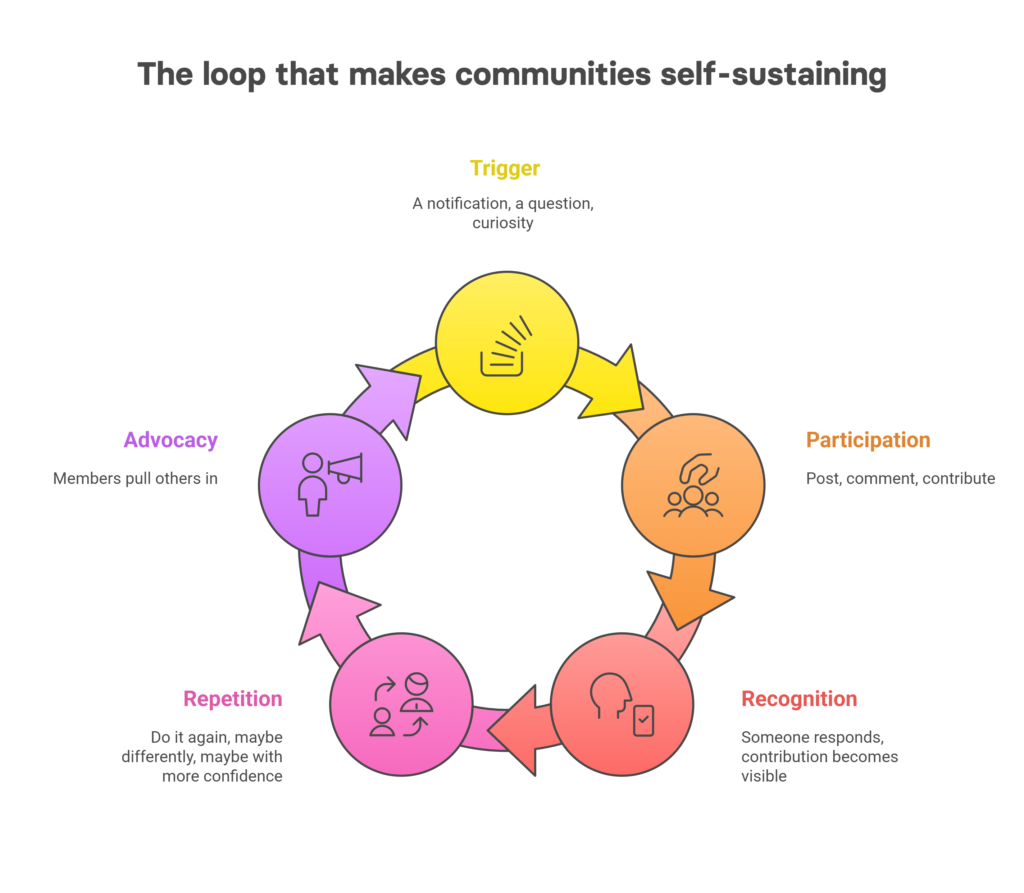
This is fundamentally different from the traditional funnel. Funnels are linear. Attract, convert, retain, repeat. Every stage consumes resources. You push people through and hope they emerge loyal at the other end. Energy flows one way and eventually runs out.
Loops are regenerative. Energy recirculates. Each action feeds the next, and value grows within the system instead of leaking out. Funnels capture. Loops continue.
Brands that design for reciprocity instead of just reach see compounding returns. Reciprocity creates rhythm. It makes people feel like what they put in comes back, not as vanity metrics, but as connection and belonging.
You can’t see this architecture in dashboards, but you can sense it. It’s the quiet hum of people responding to each other, unprompted. The quiet signal that momentum has shifted from forced to natural. The less you manually restart the cycle, the more you know it’s working.
Five ways different brands close the loop
You can tell when a community crosses from managed to self-sustaining. Moderators step back. Members answer each other’s questions. Content appears faster than headquarters can track. Growth stops feeling like acquisition and starts feeling like momentum.
A few brands have reached this point by making contribution naturally lead to more contribution.
Lego Ideas
LEGO Ideas makes recognition physical. Since 2008, fans submit designs, the community votes, and projects that hit 10,000 supporters go to LEGO’s review board. Successful sets get manufactured with the creator’s name on the box. You can literally hold your contribution in your hands. That tangible proof drives the next wave of submissions, which drives the next round of voting, which attracts more creators.
Tangible recognition drives repeat creation.
Duolingo
Duolingo built the loop into the product itself. The streak counter isn’t decoration. It’s a structural trigger. You finish a lesson, see instant progress, and that becomes your reason to return tomorrow. Users with active streaks are 3× more likely to keep learning week to week. Millions share milestones on social media, reinforcing each other without Duolingo prompting them.
What keeps users returning isn’t gamification, it’s instant feedback that builds habit through streaks.
Figma
Figma lets peer recognition do the work. Over 1 million community files and plugins circulate on their public hub. Every time someone duplicates or remixes your work, you gain visibility and reputation. The platform provides infrastructure, but users fuel the energy by teaching each other.
Visibility becomes the currency of belonging.
Notion
Notion turned templates into a creator economy. When they launched their public gallery in 2020, they invited creators to submit and monetize layouts. Top contributors now earn real income and global reach. A static resource library became a living ecosystem where successful templates inspire the next batch.
Creator monetisation turns participation into advocacy.
The Guardian and Reddit
The Guardian treats reader input as raw material. Questions become headlines. Comments become columns. They track “Reader callouts” that lead to published features. Reddit does something similar with AMAs. In both cases, audience participation becomes the content itself, creating a cycle where visibility builds trust and trust attracts more participation.
Participation feeds credibility, and credibility attracts more participation.
The pattern across all five isn’t the platform or industry. It’s that contribution becomes visible and consequential in terms the community actually cares about. LEGO turns your idea into a product. Duolingo shows your progress. Figma amplifies your work. Notion pays you. The Guardian publishes you.
People don’t return out of brand loyalty. They return because what they did there mattered. Someone noticed, responded, built on it. That feeling, repeated, transforms users into a self-sustaining community.
Use what you already have
Most brands already have everything they need. They just stopped seeing it.
The raw material is sitting in comment threads, support tickets, user-generated content, feedback emails. These aren’t random interactions. They’re signals of community energy waiting to be amplified. But brands stopped treating them that way. They became tasks. Reply to this comment. Close this ticket. Move on.
The irony? Brands are surrounded by potential loops. They just stopped completing them.
Before “community-led growth” became a buzzword, fan clubs and open-source projects ran on a simple mechanic: people contributed, got acknowledged, came back to contribute again. Nothing complicated. Just amplification of what was already happening.
Those same opportunities exist today but go unnoticed.
When you repost a customer’s photo or highlight a comment, you’re not filling a content calendar. You’re closing a loop. You’re telling someone: we saw you. That single act can transform a one-time participant into a regular contributor. But most teams treat it as nice-to-have content instead of structural fuel.
The same with predictable rituals. A weekly member spotlight. A Friday AMA. A monthly creator feature. These aren’t gimmicks. They’re emotional anchors that give people something to anticipate and return to. Yet they’re usually first to get cut when teams get busy.
Then there’s what gets measured. Healthy communities don’t optimize for impressions. They nurture feedback loops. When you reply thoughtfully to comments, link community input to product decisions, or credit contributors publicly, you’re building trust that compounds. Every acknowledgment becomes a reason to participate again. But most brands measure reach instead of reciprocity.
What’s missing isn’t budget or enthusiasm. It’s intentionality.
Loop design means deliberately structuring the flow from participation to recognition to reinforcement. When those align, momentum takes over. When they don’t, communities collapse under scattered effort.
Most brands built the foundations years ago. They buried them under automation workflows and KPI dashboards that track everything except what matters.
Community-led growth doesn’t need a new platform. It needs you to notice the loops already forming and deliberately complete them. Treat every comment, every piece of user content, every support ticket as the start of a cycle, not the end of a task.
The most powerful engagement systems aren’t built from scratch. They’re recognized and reinforced. Most brands don’t need new tools. They need new reflexes. Ways of noticing when the loop is already forming.
Design for momentum
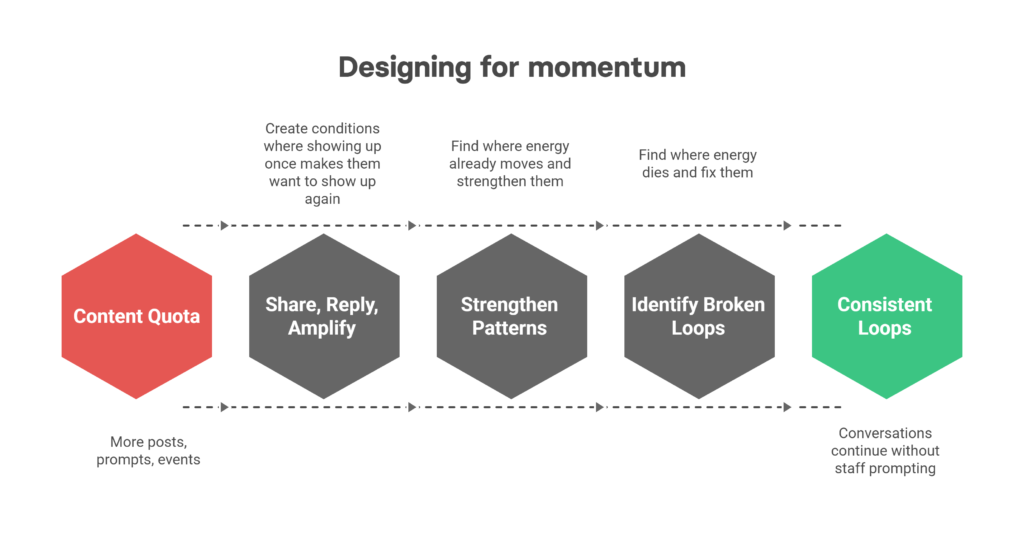
Most community teams operate like newsrooms chasing a content quota. More posts, more prompts, more events. When engagement dips, they add more. More reminders, more announcements, more “fun Friday” initiatives.
But volume isn’t the answer. People don’t engage because there’s more to consume. They engage when there’s something worth responding to.
That’s the difference between managing content and designing for momentum.
You can’t manage people into participation. You can only create conditions where showing up once makes them want to show up again. This isn’t about content velocity. It’s about energy circulation.
Every interaction has potential energy. Someone posts a comment or shares feedback. If nothing happens next, that energy dies. But if someone responds, acknowledges it, or builds on it, the energy multiplies. It circulates through the system instead of evaporating.
Healthy loops have rhythm. They survive quiet weeks because members understand the pattern. Share, reply, amplify. Over time it becomes culture, not something the brand has to manufacture.
You know it’s working when conversations continue without staff prompting. When members build on each other’s ideas unprompted. When feedback shapes actual product decisions. When rituals happen without official announcements.
This is the opposite of intensity. Many teams burn out pushing posts and hosting events, trying to manufacture enthusiasm. Great communities don’t run on intensity. They run on consistency. Small, reliable loops that keep moving even during slow periods.
Think like an ecosystem architect, not a campaign manager. Stop asking “What do we post this week?” Start asking “What patterns are forming, and how do we strengthen them?”
Find where energy already moves. Which posts spark replies? Which contributions get recognized? Where do people naturally return? Those are your loops. Don’t build new ones from scratch. Make existing ones easier to repeat.
Then find where energy dies. Contributions ignored. Conversations ending abruptly. Members participating once and disappearing. Those are broken loops. Sometimes all it takes is ensuring every contribution gets acknowledged within 24 hours.
Momentum isn’t created. It’s maintained. When you design it right, the community keeps moving when you step back. Conversations start without you. Members onboard each other. Content emerges organically.
That’s the shift from managing engagement to designing for energy.
Patterns beat playbooks
Scale is getting cheaper. Meaning is getting rarer.
AI can generate content at superhuman speed. Algorithms route attention with precision. None of that guarantees participation. Often it does the opposite. People hesitate, scan, move on. The more information floods in, the scarcer commitment becomes.
The edge isn’t just having a community. It’s understanding how energy moves through it. Where it leaks, where it compounds. Playbooks still matter, but patterns decide outcomes.
Old question: What do we publish next? New question: What behaviours keep reappearing, and how do we strengthen them?
AI will accelerate this shift. Machines can spot early loop signals. Threads that resurface. Members who reliably respond. Rituals that persist without prompts. Automation handles mechanics. But only humans create the recognition that changes how participation feels. The future is human intention on machine infrastructure.
This is why community-led growth evolves from marketing tactic to cultural system. Campaigns push. Cultures circulate. Campaigns end. Cultures persist. Communities that last are ones where members see their contribution travel. Post to response to feature to product to story, then back again. That continuity is the moat.
Zoom out and the pattern clarifies. Presence becomes table stakes. Anyone can launch a Discord. Loops become differentiators. Few design them well. Momentum becomes the outcome, what a healthy loop feels like from inside.
The question shifts from “How do we grow this?” to “Does this keep moving when we step back?” That’s the test. Energy without constant prompting. Quiet weeks don’t break it. New members learn by watching. Veterans hold centre without being asked.
Community-led growth isn’t built once and finished. It’s engineered for momentum, repeatedly, with attention to how recognition flows and where reciprocity stalls. Less about owning channels, more about stewarding patterns. Get the patterns right and growth looks effortless. Up close, it’s a hundred small loops closing, again and again, until the system runs itself.


